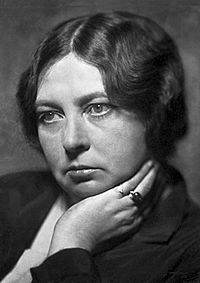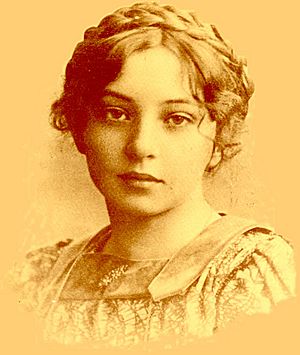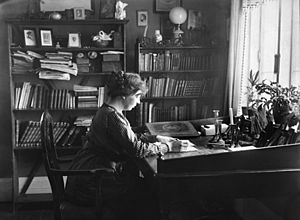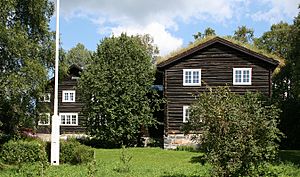Sigrid Undset facts for kids
Quick facts for kids
Sigrid Undset, T.O.P
|
|
|---|---|
 |
|
| Born | 20 May 1882 Kalundborg, Denmark |
| Died | 10 June 1949 (aged 67) Lillehammer, Norway |
| Occupation | Writer |
| Nationality | Norwegian, Danish |
| Notable awards | Nobel Prize in Literature 1928 |
| Spouse |
Anders Castus Svarstad
(m. 1912; dissolved 1927) |
| Children | 3 |
| Relatives |
|
Sigrid Undset (born May 20, 1882 – died June 10, 1949) was a famous Norwegian-Danish writer. She won the Nobel Prize for Literature in 1928.
Undset was born in Kalundborg, Denmark. Her family moved to Norway when she was two years old. In 1924, she became a Catholic. She had to leave Norway in 1940 because she was against Nazi Germany and their occupation of Norway. She went to the United States but came back after World War II ended in 1945.
Her most well-known book is Kristin Lavransdatter. This is a series of three books about life in Norway during the Middle Ages. It tells the story of a woman from when she was born until she died. The three books were published between 1920 and 1922.
Contents
Early Life and Education
Sigrid Undset was born on May 20, 1882, in Kalundborg, Denmark. She was the oldest of three sisters. Her family moved to Norway when she was only two years old.
She grew up in Oslo, which was called Kristiania back then. When she was 11, her father, Ingvald Martin Undset, passed away. He was an archaeologist.
Because of her family's money situation, Sigrid could not go to university. Instead, she took a one-year secretarial course. At 16, she started working as a secretary for an engineering company in Kristiania. She worked there for 10 years.
In 1907, she joined the Norwegian Authors' Union. She later led its Literary Council from 1933 to 1935. She was also the union's chairwoman from 1936 to 1940.
Becoming a Writer
While working as a secretary, Sigrid Undset spent her time writing and studying. When she was 16, she tried to write a novel about the Nordic Middle Ages. This book was finished by the time she was 22, but a publisher did not want to print it.
Two years later, she finished another book. This one was much shorter and was about a woman in modern Kristiania. Publishers first turned this book down too, but then they accepted it. The book was called Fru Marta Oulie. It caused a lot of talk because of its opening sentence.
At 25, Undset became a published author with this realistic novel. People in Norway saw her as a promising new writer. From 1907 to 1919, she published many novels about life in Kristiania. These stories were about everyday people, families, and the relationships between parents and children. She often wrote about women and their experiences with love.
Her realistic writing style was very clear in her novels Jenny (1911) and Vaaren (Spring) (1914). These books showed her unique view, which was different from the women's rights movements happening in Europe at the time.
Undset's books sold well from the beginning. After her third book, she was able to leave her office job and become a full-time writer. She received a scholarship for writers and traveled around Europe. She visited Denmark and Germany before going to Italy. She stayed in Rome for nine months, starting in December 1909. Her parents had loved Rome, and she followed in their footsteps. Meeting other Scandinavian artists and writers in Rome was very important to her.
Family Life and Challenges
In Rome, Sigrid Undset met Anders Castus Svarstad, a Norwegian painter. They married almost three years later. Sigrid was 30, and Anders was 13 years older. He was already married with three children in Norway. It took nearly three years for him to get a divorce from his first wife.
Undset and Svarstad married in 1912 and lived in London for six months. Then they went back to Rome, where their first child, a boy named Anders, was born in January 1913. By 1919, she had another child, and Anders's three children from his first marriage also lived with them. These were hard years for Sigrid. Her second child, a girl, had a disability. One of Anders's sons also had a disability.
She kept writing during this time. She finished her last realistic novels and collections of short stories. She also spoke out about important topics like women's rights and other moral issues. She was good at arguing her points. She was concerned about how women's rights were developing and worried about a decline in morals after World War I.
In 1919, she moved to Lillehammer, a small town in Norway. She took her two children with her and was expecting her third child. She planned to rest in Lillehammer and then move back to Kristiania. However, her marriage ended, and she got a divorce. In August 1919, she gave birth to her third child in Lillehammer. She decided to make Lillehammer her permanent home. Within two years, her large house, Bjerkebæk, was finished. It was built in a traditional Norwegian style with a big garden. Here, she could focus on her writing.
Famous Historical Novels
After her third child was born and she had a stable home, Undset started a huge writing project: Kristin Lavransdatter. She knew a lot about this topic. She had already written a short novel about an earlier period in Norwegian history. She had also retold some Arthurian legends in Norwegian. She studied old Norse writings and medieval records. She visited and studied medieval churches and monasteries in Norway and other countries. She was now an expert on the time period she was writing about.
It was after her marriage ended that Undset wrote her most famous works. Between 1920 and 1927, she first published the three books of Kristin. Then she published the four books of Olav Audunssøn, which was quickly translated into English as The Master of Hestviken. While writing these books, she was also searching for deeper meaning in her own life. She found her answers in God.
Undset used modern writing styles in her novels, like showing a character's thoughts as they happen. The first volume of Kristin Lavransdatter was made into a movie in 1995, directed by Liv Ullmann.
Becoming a Catholic
Sigrid Undset's parents did not believe in God. Even though she and her sisters were baptized and went to the local Lutheran church, they grew up in a non-religious home. Undset spent much of her life unsure about God. But her marriage and World War I changed her views. During those difficult years, she slowly started to have a crisis of faith. This led her from doubting religion to feeling worried about the moral decline of her time, and finally, towards Christianity.
In all her writing, you can see that she noticed the mysteries of life. She saw things that could not be explained by just reason or human thought. Behind her realistic writing, there was always a hint of something unexplainable. This crisis completely changed her beliefs. She had once thought that people created God, but she came to believe that God created people.
However, she did not join the Lutheran Church of Norway, where she had been raised. She became a member of the Catholic Church in November 1924. She was 42 years old. She later became a lay Dominican, which means she followed the rules of the Dominican order while living a normal life.
It is interesting that The Master of Hestviken, which Undset wrote right after becoming Catholic, is set in a time when Norway was Catholic. The books have strong religious themes about the main character's relationship with God and his feelings of sin. The Medieval Catholic Church is shown in a positive way, with most priests and monks being good characters.
In Norway, Undset becoming Catholic was a big surprise and even a scandal. It was also noticed in other countries, where her name was becoming known because of the success of Kristin Lavransdatter. At that time, there were very few Catholics in Norway, which was mostly Lutheran. Many people, including church leaders and even some smart thinkers, were against Catholicism. The attacks on her faith and character were sometimes very harsh. This made Undset use her writing skills to defend the Catholic Church. For many years, she took part in public discussions. People quickly called her "The Mistress of Bjerkebæk" and "The Catholic Lady."
Later Life and Exile
After her burst of creative writing, Undset's life became calmer. After 1929, she wrote several novels set in modern Oslo. These books had strong Catholic themes and focused on the small Catholic community in Norway. But the main topic was still love. She also published important historical books that gave a clear view of Norwegian history. She translated several Icelandic sagas into modern Norwegian. She also wrote essays about literature, especially English literature, like essays on the Brontë sisters and D. H. Lawrence.
In 1934, she published Eleven Years Old, a book about her own life. It told the story of her childhood in Kristiania, her loving home filled with ideas, and her sick father.
In the late 1930s, she started a new historical novel set in 18th-century Scandinavia. Only the first book, Madame Dorthea, was published in 1939. World War II started that same year. The war deeply affected her as a writer and as a person. She never finished her new novel. When Joseph Stalin's army invaded Finland, starting the Winter War, Undset supported Finland. She gave her Nobel Prize money on January 25, 1940, to help their war efforts.
Leaving Norway and Returning Home
When Germany invaded Norway in April 1940, Undset had to escape. She had strongly criticized Hitler since the early 1930s, and her books were banned in Nazi Germany. She did not want to be found by the Gestapo. So, she fled to neutral Sweden. Her oldest son, Anders Svarstad, who was a soldier in the Norwegian Army, was killed in battle on April 27, 1940. He was 27 years old.
Undset's daughter, who had a disability, had died shortly before the war began. Her home, Bjerkebæk, was taken over by the German army and used as officers' living quarters during the occupation.
In 1940, Undset and her younger son left Sweden and went to the United States. There, she worked tirelessly to speak up for her occupied country and for the Jewish people in Europe. She did this through her writings, speeches, and interviews. She lived in Brooklyn Heights, New York. She was active in a Catholic group called St. Ansgar's Scandinavian Catholic League. She also became good friends with the writer Marjorie Kinnan Rawlings in Florida.
After the German army killed a Danish pastor named Kaj Munk in 1944, a Danish resistance newspaper printed articles from important Scandinavians, including Undset, condemning the act.
Undset returned to Norway after it was freed in 1945. She lived for four more years but did not publish any more books. Sigrid Undset died at 67 in Lillehammer, Norway, where she had lived for many years. She was buried in the village of Mesnali, near Lillehammer. Her daughter and the son who died in battle are also remembered there. Her grave has three black crosses.
Honors and Legacy
- Sigrid Undset won the Nobel Prize for Literature in 1928.
- A crater on the planet Venus was named after Undset.
- Undset was featured on a Norwegian 500 kroner banknote and a two-kroner postage stamp from 1982. Sweden also put her on a stamp in 1998.
- Bjerkebæk, Undset's home in Lillehammer, is now part of the Maihaugen museum. The house was listed as a historic site in 1983. Work to restore and furnish the houses as they were when she lived there began in 1997. New public buildings were opened in May 2007.
- Undset is pictured on the tail fin of a Norwegian Air Shuttle Boeing 737-800 airplane.
Major Works
- Gunnar's Daughter is a short novel set in the Saga Age. This was Undset's first historical novel, published in 1909.
- Gunnar's Daughter, ISBN: 0-14-118020-X
- The Master of Hestviken series has four books, published from 1925 to 1927. The books are listed in order below.
- Kristin Lavransdatter is a series of three books. These were written between 1920 and 1922.
- Jenny was written in 1911. It tells the story of a Norwegian painter who travels to Rome for inspiration. Things do not go as she expects.
- Jenny, ISBN: 1-58642-050-X
- Happy Times in Norway is a memoir about her children's life in Norway before the Nazi occupation. It includes a powerful introduction about Norway and its people. New York; Alfred A. Knopf. 1942. ISBN: 978-0-313-21267-3
- True and Untrue and Other Norse Tales 1945, by Alfred A Knopf. Reissued 2012 by Pook Press; ISBN: 978-1447449607 (hardcover)
- Saga of Saints, ISBN: 0-8369-0959-3; ISBN: 978-0-8369-0959-3. This book tells stories of saints.
- Ida Elisabeth, novel
- Ida Elisabeth (San Francisco: Ignatius Press, 2011), ISBN: 1-58617-424-X
- Catherine of Siena, Novel. Sigrid Undset's book about Catherine of Siena is considered one of the best biographies of this 14th-century saint. Undset based her work on original sources and her own experiences in Italy. Catherine of Siena was a favorite of Undset, who was also a Third Order Dominican. This novel was republished by Ignatius Press in 2009.
- Catherine of Siena (San Francisco: Ignatius Press, 2009), ISBN: 978-1-58617-408-8
- Stages on the Road is a collection of saints' lives, published in 2012.
- The Wild Orchid is a novel set in 20th-century Norway and published in 1931. The title refers to the main character's mother's garden.
- The Burning Bush is a follow-up to The Wild Orchid, published in 1932. It looks at the problems the main character faces after becoming Catholic.
Images for kids
See also
 In Spanish: Sigrid Undset para niños
In Spanish: Sigrid Undset para niños










